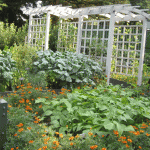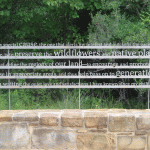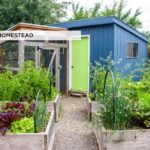Mount Vernon was the estate of George Washington and it is located right outside of Washington DC, about a 30-45 minute drive. A sign on the estate reads “While the world remembers him as a great military and political leader, George Washington would have told you he was first and foremost as a farmer.” He was so devoted to the garden that he would write letters with specific details on its care whenever he needed to be away for a period of time.
The above pictures is of the orangery, a structure popular back in the 17th, 18th and 19th centuries on large estates. It is used today as a meeting space, but originally would have houses exotic citrus plants that Washington collected from around the world. The outside garden is a classic, formal knotted design. Next to is a wild ornamental flower garden where the large citrus trees have been rolled out for the summer months.
Crop rotation today seems like a no-brainer. You rotate what you grow to a new space each season to give the soil a chance to recover and use some cover crops to build it back up. This was a really new idea though back in the late 18th century and Washington was an early farmer to practice crop rotation.
Small details like fencing are pretty interesting on the estate. This rustic split rail fence was used to keep the sheep in a large field. Split rail fencing is movable and works well when you need to arrange it around trees or other obstacles.
We saved the best for last during our four hour visit to Mount Vernon: the vegetable garden. Amazing! Facing toward southern exposure, the space is enclosed with brick walls that protect the crops from critters and create a warm micro climate that extended the growing season.
There are 2-3′ high espalier fruit trees creating a hedge around the paths. Can you believe that? These trees have to been tightly pruned for so long! Bushy lavender and rosemary were other gorgeous plants used as hedges in this garden.
I probably don’t need to include two panoramas of almost the same spot in the garden, but I am going to anyway. Click on the pictures for a larger view. This one shows the water pool in the middle and the geometric design of the garden beds that hold vegetable crops. Grape vines loosely hang off the open fencing around the space.
And from another angle, here you can see the taller espalier fruit trees that grow along the brick walls that enclose the vegetable garden. I love all the vegetable crops planted in geometric patterns, the edible hedges, and the life that is bursting from this space. What an inspiring garden!












 This cluster was about the siz
This cluster was about the siz




 I start with a
I start with a


My family took me to Mount Vernon many years ago. I really liked it. I have always admired George Washington and seeing his home helped me feel a little closer to this great historic figure.
I was there in the winter though. I had no idea the gardens were so spectacular. I mostly remember the inside of his house.
If you liked Mount Vernon, you’d LOVE Monticello. Especially in the spring when everything is blooming!
Oh my, those gardens are stunning!
I’ll be in Monticello this weekend! I have been so excited to see it before we leave the east coast.
and right by mt vernon is george washington’s daughter’s estate named woodlawn on the mt vernon grounds which is not busy at all. i just re-visited mt vernon a few months ago and loved it. we also visited the frank lloyd wright house as well as nelly washingon’s house. thanks for sharing your photos.